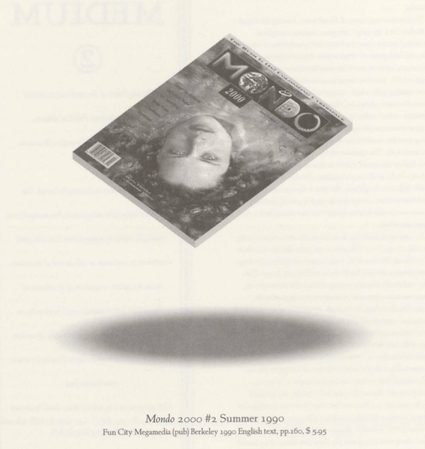Synchro Energizer (Deep Relaxation, Hyperleaming. Brain Balancing). It would appear to be some kind of god-forgotten psychedelic paradise for the brain. A straight line runs from the liberation of the mind by means of drugs to the liberation of the mind by means of the most ultra- modern technology. But the biggest drawback to this sort of ecstasy is the neglect of the body; while the mind inhabits higher realms, basking in the psychotropic effect of mushrooms or electronics, the body is left behind in a somewhat desolate state and remains a prisoner of the earthly, deadly-dull atmosphere of reality.
Of course, we know of the sexual revolution of the Sixties, the physical and aggressive explosions of the Seventies (new wave, punk), the retro-revolutions and aesthetic-regressive trends of the Eighties (new age, acid house, vogue, speed metal, garage rock), and yet these attempts to sever the body from its moorings and to launch it in the same way as the mind have never really satisfied. But with the introduction and coining exploitation of virtual reality in the Nineties, both mind and body can get high in cyberspace, in the hallucinatory matrix-space of the computer networks.
The summer 1990 issue of Month 2000, bearing the slogan The Rush is On: Colonizing Cyberspace, contains a couple of astonishing articles about the future and possibilities of virtual reality, the high point of which is John Barlows interview with Jaron Lanier. Lanier is one of the founders of the computer company VPL, which at this moment is working on a DataSuit, a Cyber costume with which, as opposed to the already known glove-and-monitor-glasses set, allows the entire body to experience virtual reality. In that way, the body literally becomes one giant sensorium (metaphorically, as regards the stimuli coming from the world of the media, the body already was one giant sensorium). The question which automatically occurs, and which Barlow also poses, is how in heavens name can one still speak of a 'body' at all. Laniers answer: Oh, it's a body, it's just not a particular body. It's a thought body. The thing is, the way your body is in Virtual Reality doesn I correspond to the extent of your physical body. We just create some transfer function between what your physical body is doing and your virtual body.
As soon as the body has been converted into a virtual body, it can take on any form: a dolphin, a star constellation, Napoleon or Cary Grant. Because of the body’s renewed ability to undergo metamorphoses, identity finally finds itself in real danger. This measly and deadly identity concept is untenable from now on, because we have a reservoir of images at our disposal in its entirety. Thanks to high technology, we are once again capable of enjoying our original primitivity. that is. the concrete and magic power to become something else. The idea alone that handling images will come down to witchcraft and shall have nothing to do with information or communication is exciting. And even the relationship with the world will then no longer be abstract and functional, but, rather, concrete and magical. Lanier: In Virtual Reality the whole world is your body - equally - and everybody shares the same body. (...) You know how Alan Watts once formulated the universe as a creature that looks at itself in a million ways and each of the ways was a person? Virtual Reality is a reality just like that.
But, along with this practically Borgesian image of an eternal, kaleidoscopic world body, Lanier also holds up before us the image of Virtual Reality as the ultimate neutraliser of evil: It denatures the bad, because the good is inherently natured when it's sucked up into Virtual Reality. Here's where the story goes completely awry. When Laniers intentions, and, generally, those of Mondo 2000, become clear, the magic powers of virtual reality turn out to have been infected with the conception of the Good. In this hyper-hip magazine, the ideals of the Sixties seem to be thriving luxuriantly: the end of the media and the ignominious interface, the end of bad technology, the end of power and of all hierarchy, the return of individual freedom, experience and communication.
In and of itself, of course, the Good can do no harm. It only becomes irritating when it gets the upper hand as a principle, or when it is preached in a hysterical fashion, as does cyber-priest Timothy Leary. Striving for total goodness always implies total purging, and history has already demonstrated what the consequences of that can be.
Whether we’re cybernauts, hackers or hippies, our salvation is that there will never be a ‘good’ computer technology or a ‘good’ virtual reality, any more than such a thing as a 'good' drug will ever exist.
translation Jim Boekbinder
